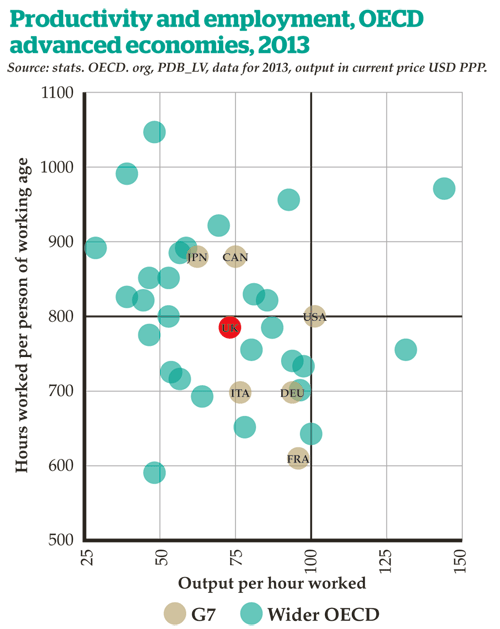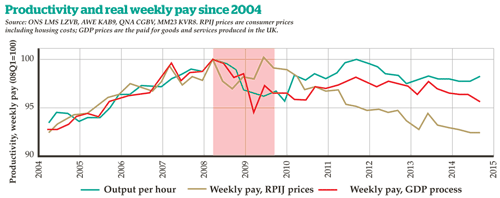Untangling the track: the role of skills in boosting productivity
By Michael Davis
Chief Executive, UK Commission for Employment and Skills
“How did the track get ‘tangled’ in the first place?” asked my young son, after seeing a sign at London Bridge station advising passengers about the ongoing engineering works.
I tried to explain that the track wasn’t tangled in the same way as a set of headphones might be, and that the notice was about the work being done to improve how trains enter and leave the station. “More trains and fewer delays,” I added. But my son remained unconvinced, and I turned to Google for a better explanation.
“Untangling the track” at London Bridge is, at its core, seeking better outcomes for a given set of inputs. And it neatly illustrates the ‘productivity puzzle’ that has recently filled many column inches. The economy is ticking along fine (robustly actually, with strong employment and growth), but our achievements are based on doing ‘more and more’ rather than doing more and doing it better.
How to fix productivity growth in the UK has no simple or single answer. The solution will be multi-faceted, and require collaboration between a number of different parties, including employers, government and educational institutions. However, we at the UK Commission for Employment and Skills (UKCES) believe that the skills of the workforce - and how these are put to use in the workplace - should be part of that solution.
The recession of 2008 and 2009 is distinct from previous ones in three ways. Firstly, the loss of output was unparalleled in modern times, and took some time to recover. While the economy is once again expanding robustly, productivity growth has stalled at levels some way behind those in the US, Germany or France (see chart, right). If we were to match the productivity levels of the US, every family would be about £21,000 better off every year (Fixing the foundations: Creating a more prosperous nation - Her Majesty’s Treasury, 2015). In contrast, in the recessions of the early 1980s and 1990s, productivity growth continued and the economy was back on the mend more quickly.
Secondly, given the gravity of the 2008 crisis, the fall in employment was milder than might have been expected. At its peak, unemployment only reached 8.6%, significantly lower than the dizzying heights of 12% in the early 1980s and 10.8% in the early 1990s.
Unemployment is also recovering much more quickly than it has done previously, and is already approaching levels typical of the pre-recession period. Encouragingly, the improvement is down to economic growth rather than individuals withdrawing from the labour market, as has been the case in some advanced economies.
Third is the fall in pay. Although the latest indications are that pay in real terms is beginning to grow once more, the 2008 recession marked the start of a sustained decline in pay, of a kind unseen in the post-war era.
The explanation for the fall in wages could be attributed to workers willing to accept lower remuneration to maintain employment. But as unemployment returns to pre-recession levels, that reasoning starts to look weak. One alternative is that wages have fallen because productivity has fallen. Mapping growth in productivity to changes in pay seems to suggest a link between workplace productivity and employee earnings (see chart, opposite).
During the 1990s and 2000s, skills played an important and sustainable role in driving productivity growth. As the opportunities to participate in higher education increased, so came a substantial boost to the supply of high-skilled workers.
And the expansion of the talent pool has continued, making a positive contribution to productivity growth every year, even during the recession. We forecast an increase in those qualified to
Level 4 and above from 37% to 47% by 2020, with the fastest growth in post-graduates (Levels 7-8). We also project a decrease in the proportion of the population that holds no qualifications, from 9% to 6% (UK skill levels and international competitiveness, 2013. Evidence Report 85, UK Commission for Employment and Skills, Wath-upon-Dearne).
Compared with other OECD members, the UK fares well on higher-level skills (those with a tertiary education), ranking 11th out of 33. But lower down the skills hierarchy, the UK’s performance starts to falter. It stands 24th for intermediate skills, with 37% of the population holding upper secondary qualifications. And it ranks 19th on low skills - 18 OECD countries have fewer people with low skills (below upper secondary education) than the UK, including Japan, the Czech Republic and Slovakia.
So the UK does well in generating highly qualified workers, but is much less successful at developing the skills of the rest of the workforce. The OECD’s survey of Adult Skills found that a significant minority of adults in the UK have a very low level of proficiency in literacy and numeracy. The findings also depict a worrying gap in the UK’s workforce between the skills-rich and the skills-poor. And this polarisation is at risk of becoming even more pronounced, as those who have previously engaged in learning are much more likely to continue to do so.
The UK excels at creating high-skilled jobs. During the past decade, the UK has added more of these than any other European Union member state - 2.2 million from 2006 to 2013, out of a total of 5.1 million added across the EU.
The rise in high-skilled work in the UK has been a positive development. It has meant that the economy has been able to support a rapid expansion in the graduate workforce, while maintaining the higher rates of pay that graduate jobs tend to offer.But, while trade and technology complement high-skill labour in doing complex and creative work, they also substitute middle-skill labour engaged in more routine tasks. Comparing 1992 and 2022, there will be some additional seven million high-skill managerial and professional jobs alongside 2.4 million additional service-intensive roles. These gains sit in contrast to a loss of two million middle-skill jobs and 0.7 million labour-intensive roles. Over a 30-year period, the UK economy will add 6.7 million net new jobs, and nearly three-quarters of those new jobs will require high-level skills.
The shrinking in the number of middle-skill jobs means a loss of opportunity for those not able to enter high-skill jobs. Where once low-skilled workers could progress towards middle-skill roles as the basis of a career characterised by decent pay and progression, there is the risk that many now end up in low-paid jobs with few opportunities to move up. The loss of middle-skill jobs will lead to an increasing number of displaced middle-skilled workers, or new workers who will struggle to start a middle-skill career.
The squeeze on the middle has affected young people in particular. While the over-30s and the over-50s have experienced a fall in their share of middle-skill work, this is more than offset by an increase in their share of high-skill work. Instead, 22-29-year-olds have seen a decline in middle-skill work and (since 2005) in high-skill work. So where established workers either stay in middle-skill work or move up, young workers are finding it more difficult to enter into middle-skill work and climb the career ladder.
One way to improve young people’s access to high-skill jobs is to forge clearer vocational pathways. The potential benefits of this are reflected in the economic returns already achieved by high-level vocational learners.













